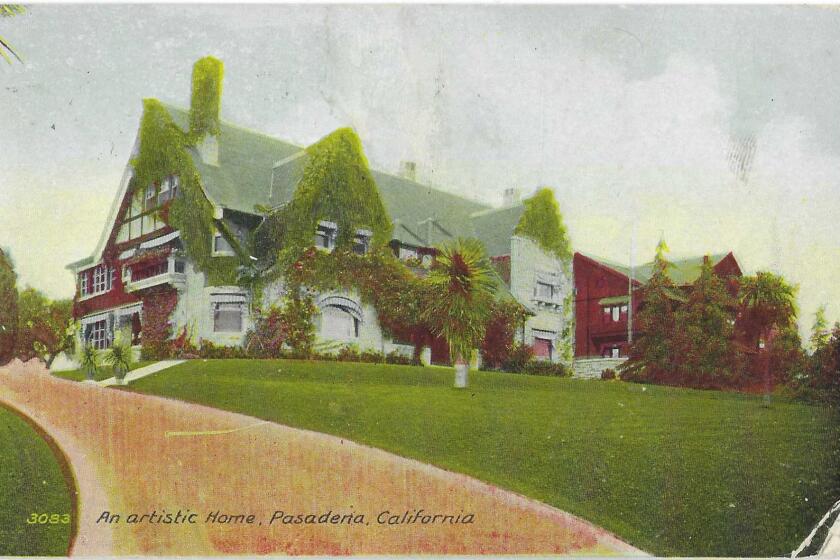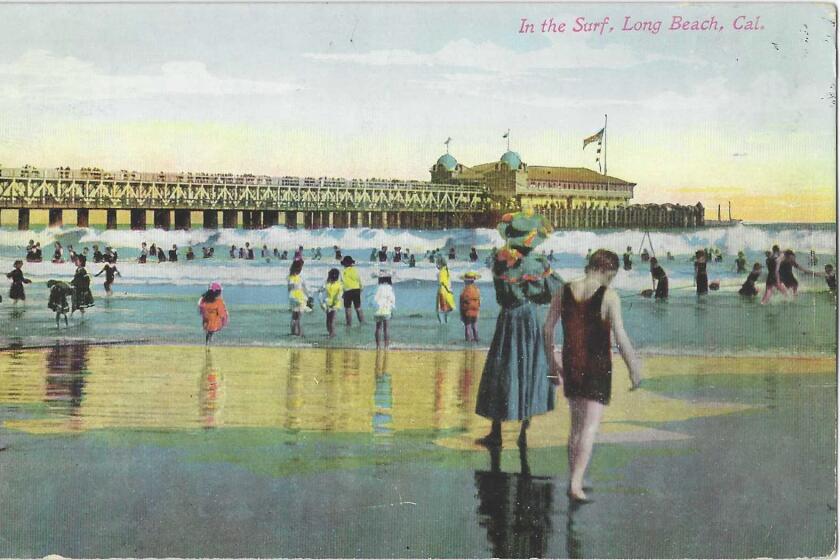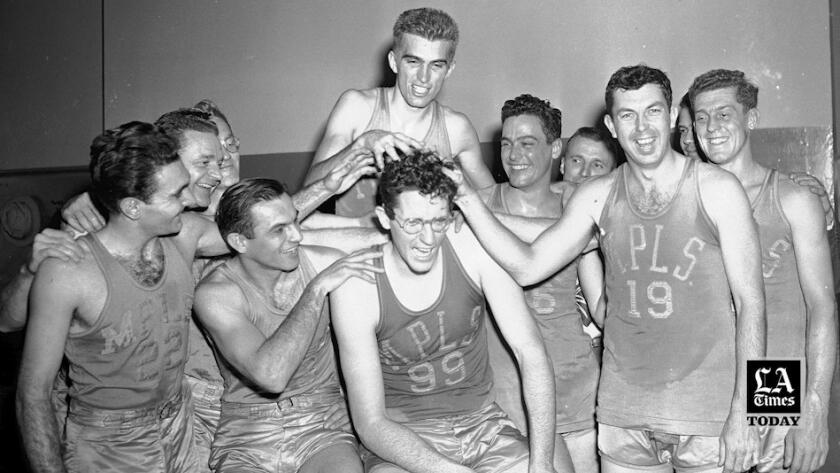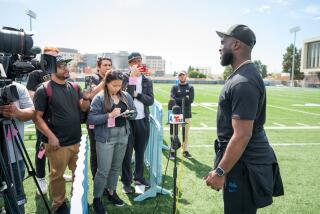Los Angeles, land of the misnamed sports teams
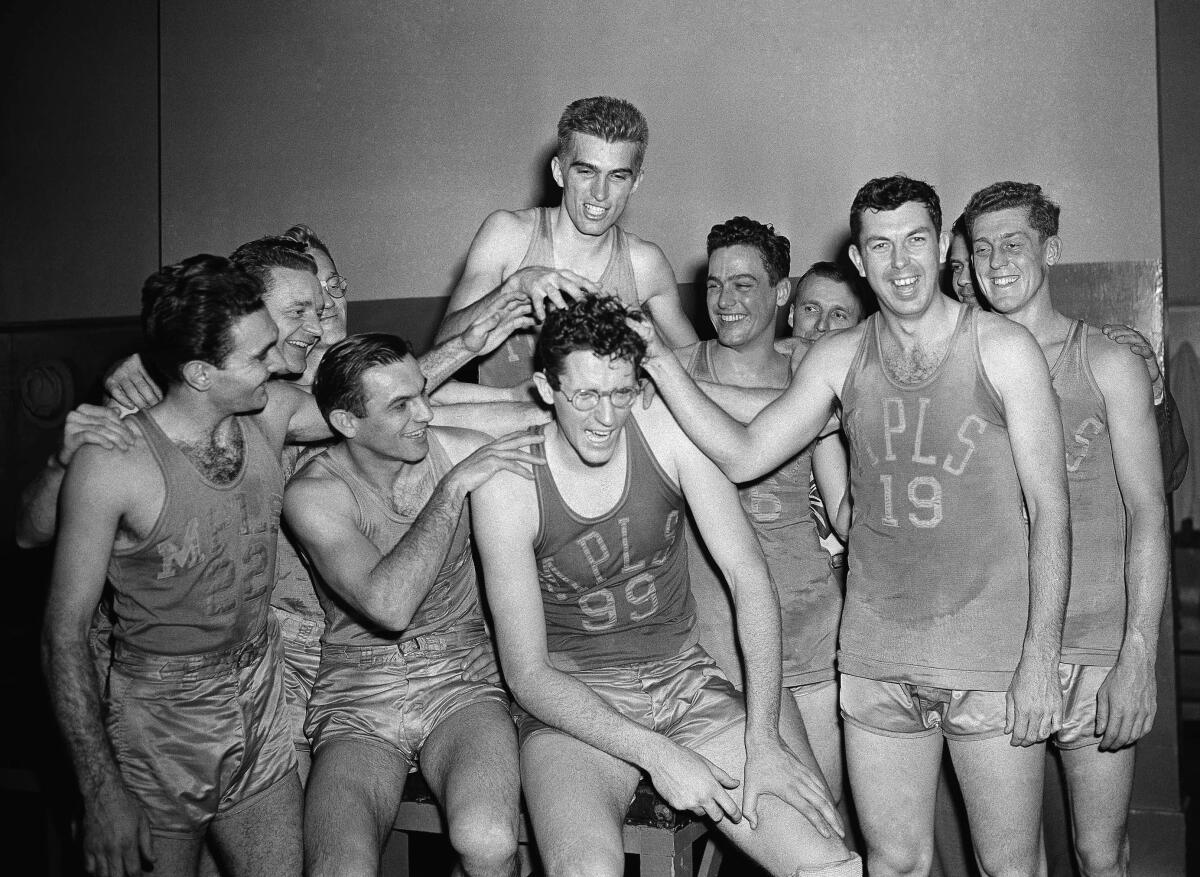
- Share via
Maybe it’s because we’re neighbors with Hollywood’s mirage machine that we can cohabit so easily with irony.
How else to explain how we’ve spent more than 60 years cheering for a team that’s named after luscious bodies of water that exist only in Los Angeles’ yearnings?
The Los Angeles Lakers were named for their old hometown, Minneapolis, and for Minnesota’s slogan, “Land of 10,000 Lakes.” Now the team is here, in the “Land-of-Good-Luck-Finding-a-Lake.” (If I had my druthers, the team would be “the Arroyo Secos.”)
Journalist Paul Lukas, the creator of the UniWatch sports website, wrote, “When I was a kid in the 1970s, I had no idea that the Lakers had moved to L.A. from Minneapolis, so I mistakenly thought that the team name was based on the city name —“L-A-kers,” get it? It works!”
Many of our teams are, like us, immigrants and newcomers, yet like us, they flourish, even when they keep a hand on their old handles.
Explaining L.A. With Patt Morrison
Los Angeles is a complex place. In this weekly feature, Patt Morrison is explaining how it works, its history and its culture.
Most celebrated, of course, are the Dodgers. To the Brooklynites who bear us a long grudge, we not only stole their team, we stole their team name, the Brooklyn Trolley Dodgers, but callously snipped away the front end like some vestigial appendix. (The trolley part was for the acrobatics of crossing Brooklyn’s welter of streetcar tracks.)
But their memories may fog conveniently in this: Major League Baseball’s website notes that “trolley dodgers” was an off-and-on moniker. The fickle team also used other names: the Bridegrooms (for the year when so many players got married), the names of different team managers, and a vaudeville act. Not until 1933 did the Brooklyn team put “Dodgers” on its uniforms, and in 1958, that team and that snipped name were in Los Angeles.
Here’s a nice bit of trivia symmetry for you. One year and one day after Los Angeles’ trolley, the Red Car, made its final journey, the sans-trolley Dodgers played their first game at Dodger Stadium. April 9, 1961, and April 10 1962.
Like fragile flowers, some team names don’t survive transplantation. You’d have thought that “Lakers” would be one of those, but flourish it did in this arid soil.
The San Diego Padres, named for the 18th century Franciscan founders of the Spanish mission there, would make no sense anywhere else, nor would their mascot, the Swinging Friar — the “swinging” bit for his at-bats, not his social life.
Pro football’s Houston Oilers upped sticks and moved to Tennessee, but after a couple of seasons, it became clear that no one was striking oil in Nashville, so they re-branded themselves the Titans. Now, “Titan” sounds like a Marvel character, but it comes from long ago. Nineteenth century Nashville christened itself “the Athens of the South,” a citadel of learning, like the Athens of ancient Greek. Hence the Titans, gods of Greek myth. The team should offer a free ticket to random fans-on-the-street who know this.
L.A.’s public beauty spots deserve a visit, by all means. But it’s the houses that surprise visitors and gratify us, even if they can only be glimpsed from a sidewalk.
The Tall Ships
Now, as for the Clippers, the NBA team playing in the penumbra of the Lakers’ gold-and-purple aura: If you’d never heard of the team before, you might think that the team name and mascot was a barber. (Well, I did.) For modern Californians, the origin might be just as obscure.
In the 19th century, the clipper ship was the swift and beautiful workhorse of the world’s mercantile fleets, a ship whose remnant memory we find in the phrase “at a fast clip.” These ships swarmed San Diego’s fine natural harbor, which the seafaring Harvard man Richard Henry Dana described in 1835 as “the best harbor on the coast.”
The San Diego team became the Clippers in 1978, and six years later carried that name up the coast to Los Angeles, a place that had no comparably deep natural harbor.
I asked my friend Alonzo Bodden, the comedian and most forbearing of Clippers fans, what he thought of a team named for a nearly 200-year-old sailing vessel, and its present plush-fur feathered mascot, Chuck the Condor.
“Have to say I’m not a fan of Chuck the Condor. I get it — the California condor is nearly extinct. But isn’t it that kind of a bad omen? The Clippers are named after clipper ships. Couldn’t we have a pirate or a sailor? Why an indefinable bird? Don’t we have enough problems?”
I take Alonzo’s side here; if you’re going to call your team the Clippers, then a real clipper ship captain mascot would cut a fine figure courtside.
In early 1985, the L.A. Clippers did briefly have a sea captain mascot who made no impression whatsoever, and was soon replaced by Sam Dunk, who looked like nothing more than a geezer kitted out for a weekend pickup game, and whose most memorable moment may have been when he tried to pull a pretty blond fan onto the court to join him in a happy-clappy routine. She resisted. It turns out to have been Shelly Sterling, the team owner’s wife, and in their brief tugging, Sam Dunk managed to tug off the boss’ wife’s bracelet.
Sam Dunk never dunked.
Divine provenance
The Los Angeles Rams have also been the Cleveland Rams, the Los Angeles-Rams-of-Anaheim-Stadium, and the St. Louis Rams. Fordham University, the Jesuit institution in New York, claims to have blessed the team with its name, thanks to some priggish divines at the school.
As Fordham tells it, the school sports cheer in the 1890s went like this: “One-Dam, Two-Dam, Three-Dam, For-dham!” Once the Jesuit fathers got wind of this, they insisted that “dam” was out, and thus “ram” was in.
Decades later and hundreds of miles to the west, when it came time to name Cleveland’s new AFL team in the 1930s, a confab of investors and columnists got together to kick it around. As the Fordham Observer describes it, the newsmen argued for a short name that would fit into headlines. Someone — perhaps a Fordham grad — put forward “Rams.” The name stayed with the team even when it moved to California right after the war and left Cleveland’s pro football field to that new team, the Browns. (I always liked the striking visual of the Rams’ helmets and the movie-marquee names of L.A. players: Norm Van Brocklin, Roman Gabriel, Elroy “Crazy Legs” Hirsch, Aeneas Williams.)
Now, on to the Chargers. That’s a pretty portable name, and rather farsighted, as it turns out, considering that it predated by a few decades our cellphone chargers and electric car chargers. The team has had to spend way too much energy on whack-a-mole denials that the founding owner, Barron Hilton, dreamed up the name to promote his credit card company Carte Blanche (they called it a “charge plate” then).
No no, he told The Times’ Bill Dwyre more than a dozen years ago. “It was after the trumpet call, followed by the roar of ‘Charge,’” Hilton said. “It never had a thing to do with the credit card.” Me, I’d root quixotically for an antiquated meaning of “charger,” a valiant warhorse, like Lochinvar’s steed, certainly a more engaging character than a bolt of electricity.
Barron Hilton’s Chargers turned short stay into long-term success
Most good team names — relevant or not — work best as two syllables, with the accent on the first one, in particular for the timeless team chant, “Let’s go BLANK blank.” DOD-gers, CHAR-gers, AN-gels.” Sorry, Rams.
A team of their own
Oh, the poor Angels. Their name has been one prolonged battle about —what else? Location, location, location. They have played for years in Anaheim, in Orange County, yet they’re historically and legally yoked to L.A. in a freeway-friction cousinship to which L.A. is pretty much indifferent but one that grieves Orange County. Really, you could almost make of Orange County’s unfortunate geography some version of long-ago Mexican President Porfirio Diaz’s lament for his own country: “So far from God, so close to the United States.”
Anyway. Los Angeles had a baseball team called the Angels as far back as 1892, when The Times wrote it up as such, back when the California League held sway. Ownership and affiliation got sold and swapped around over the years, and in 1966 it became an American League team playing in Anaheim as the California Angels.
After a new owner bought the team in 2003, he put “Los Angeles” back on the team name, and so legally, for a time, the team had to be the cluttered, confusing “Los Angeles Angels of Anaheim.” Anaheim besought the court’s help but lost, and the team became just the Los Angeles Angels once more.
But Anaheim will always have the Ducks — well, at least for now. Disney’s chairman, Michael Eisner, decreed in 1993 that the new National Hockey League team should bear the same name as a Disney hockey movie, “The Mighty Ducks.” The team, maybe improbably, performed even better than the movie (audiences loved it, critics meh). In 2006, the team changed hands and the new owners dropped the “Mighty” bit. Win or lose, “Ducks” is still a better name than the nondescript, aspirational “Los Angeles Kings,” a name that owner Jack Kent Cooke supposedly believed gave an air of regality to his team. It’s a great name when you’re winning, but not so much when the season turns up a joker.
Adding a touch of suspense to a gala press conference to announce the expected--that Walt Disney Co.’
There is of course the Los Angeles Football Club soccer team, a generic team name with about as much pizzazz as a grocery-store bag of flour labeled “flour.” The brand-new Angel City football club, a women’s team owned by a stellar array of female actors and athletes, intended “Angel City” as a placeholder name until it chose a permanent one, but it looks like Angel City it will be, in spite of the fact that a roller derby league had first claim on the Angel City name. Wheels or feet, they both have wings.
Vanishing stars
You may be wondering, where is Hollywood? Apart from Disney’s poultry-movie team, is no one capitalizing on the proximity to filmland?
From the last full year of silent movies, 1926, until 1938, the Hollywood Stars played in the Pacific Coast League on borrowed turf, the old Wrigley stadium in what is now South L.A., a place that’s a good story for another time. The team owner moved his club south to San Diego, where it would grow up to become the Padres. The Hollywood Stars had already knocked around for a couple of decades before coming to L.A.; its previous incarnations were the Fresno Raisin Eaters and the Sacramento Solons. Solons is an ancient Greek name that became a synonym for “legislator,” a word beloved by headline writers but a mystery to almost everyone else.
The Stars were revived in 1939, the greatest year in the history of American movies. They played at Gilmore Field, owned by the Gilmore family, which made a fortune in oil and owned the property where Farmers Market and the Grove now stand. From 1939 until 1957, when the Dodgers big-footed L.A. baseball, the Gilmores fielded the Hollywood Stars. It was a see-and-be-seen place for movies’ celebrated faces, the stars who turned out for horse races at Santa Anita and auto races at Gilmore Stadium.
Maybe the Stars’ biggest Hollywood splash was its cheesecake moment in 1950. Columns by Times sportswriter Braven Dyer about better sports equipment and uniforms getting better results inspired the team manager to whip up a uniform of rayon shirts and pinstriped white flannel shorts. Some of the players loved the cool, lightweight gear. The bare-knees look lasted for just four seasons.
The Stars’ connection to movies lives on, more or less, in the Galaxy soccer team, named for the formation of tens or even hundreds of billions of stars, so you can’t say the team isn’t thinking big. Its mascot Cozmo, so the team story goes, made an emergency landing in Carson, failed to make the team, but stayed on as a mascot. At least give that critter a jet pack, won’t you, so there is something extra-worldly about him?
Our two top college teams — the ones defecting to the Big Ten, so let us not speak their names — are called Bruins and Trojans. The Bruins were originally the Grizzlies, as the southern counterpart to UC Berkeley’s Golden Bears, but changed to Bruins in the 1920s when they signed on with the original Pacific Coast college conference, which already had a Grizzlies team. As for the Trojans, more than a hundred years ago, Times sportswriter Owen R. Bird compared the university’s stalwart track team to the Greek soldiers of the city of Troy, so Trojans they became.
Personally, I prefer the modern names that reflect students’ spirit. UC Irvine sends the Anteaters onto the field and the court. UC Santa Cruz students chose a small bit of local fauna, the Banana Slugs, to replace a much larger one, the Sea Lions.
After Stanford University sensibly gave up its “Indians” team name in 1972, students voted on a new school team name. They overwhelmingly chose “Robber Barons,” a dig at Stanford founder Leland Stanford, one of California’s “Big Four” tycoons who called the shots in California for decades. Unamused, the administration refused to honor the students’ wishes. Now Stanford fields teams called the Cardinal, singular, not plural, for the school color. Go Crayola, rah rah rah.
Team mascot characters are worth delving into more deeply another time, but I was delighted to learn of the existence of the National Mascot Assn., motto “Fuzzier Together, Safer Together,” offering deportment advice, insurance hints and tips such as “Have a handler or spotter at all times when performing,” and “Never pick up or hold babies, toddlers, or small children.”
I don’t know whether this association means they’re unionized, but I would pay cash money to see all those sports mascots walking a picket line.
Postcards promoting Southern California beachgoing are colorful affairs, except for the people depicted. Many beaches were off-limits to nonwhite people for decades.
- Share via
Watch L.A. Times Today at 7 p.m. on Spectrum News 1 on Channel 1 or live stream on the Spectrum News App. Palos Verdes Peninsula and Orange County viewers can watch on Cox Systems on channel 99.
More to Read
Sign up for Essential California
The most important California stories and recommendations in your inbox every morning.
You may occasionally receive promotional content from the Los Angeles Times.

